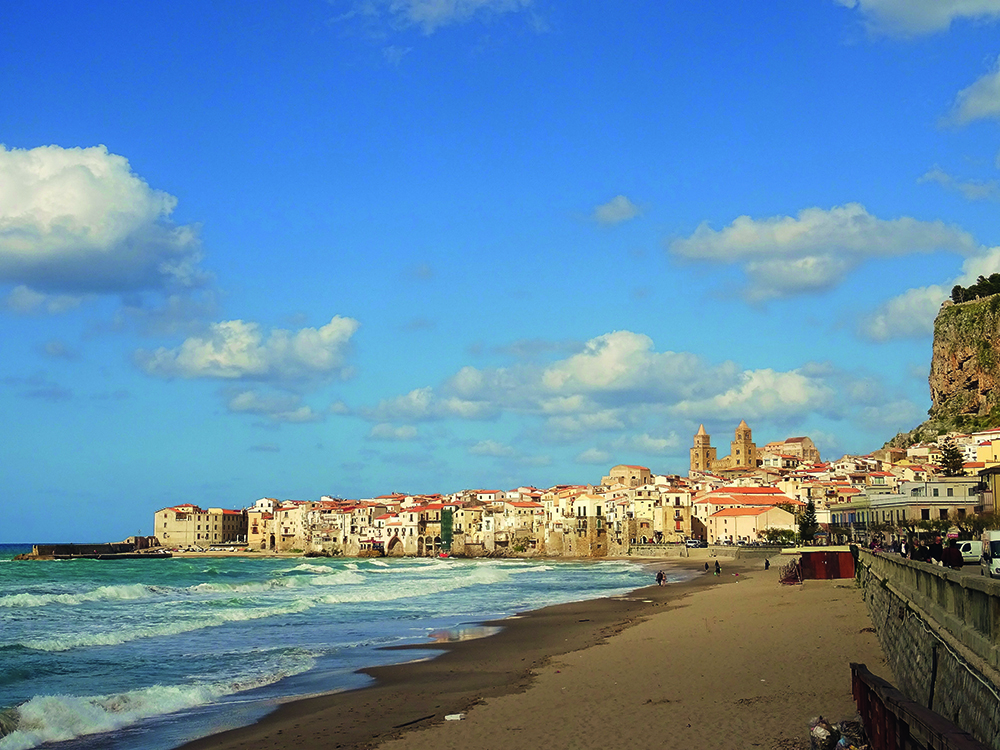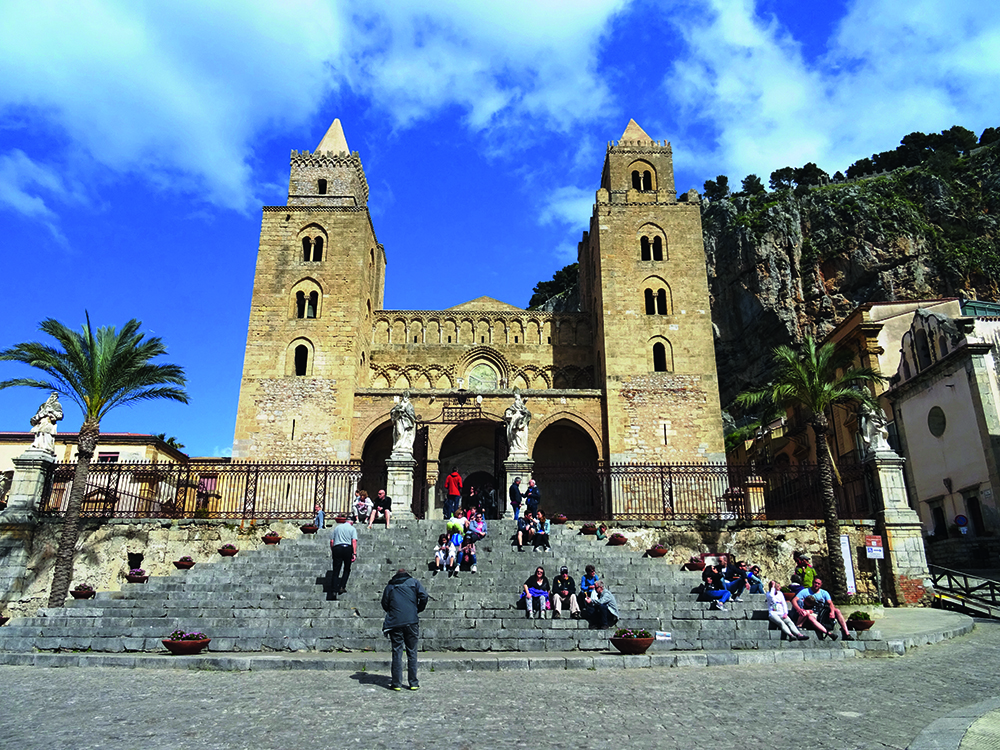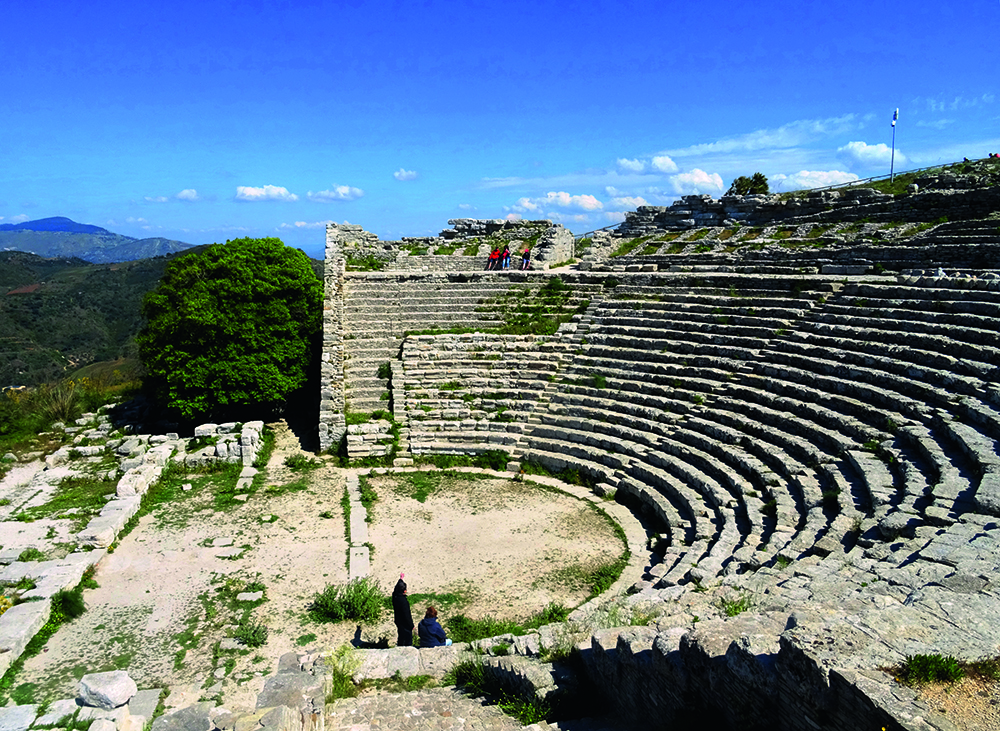Motorhome travel: Exploring Sicily
Our Sicilian motorhome adventure was inspired by the BBC2 programme, Sicily Unpacked. Three months later we were in the ferry queue and staring at the mysterious island, looking forward to sampling its history, culture and cuisine.
After the 20-minute crossing to Messina, the ramp dropped and the locals did everything possible to avoid disembarking in orderly fashion. As we soon learned, rules are superfluous in Sicily! We wild camped on a beach near Patti in view of the Aeolian islands before driving to Cefalù.
 Waves thundered onto the beach and the huge rock outcrop, La Rocca, towered over the town. Once an Arab citadel, a Norman castle was built in 1061. The narrow streets are paved with shiny, black, volcanic stone. Walls are weathered ochre and tall buildings have neat wrought-iron balconies overhanging the streets.
Waves thundered onto the beach and the huge rock outcrop, La Rocca, towered over the town. Once an Arab citadel, a Norman castle was built in 1061. The narrow streets are paved with shiny, black, volcanic stone. Walls are weathered ochre and tall buildings have neat wrought-iron balconies overhanging the streets.
Piazza del Duomo slopes up to the steps of the twelfth century cathedral. Legend says Roger II built it in thanks for his fleet being saved in a storm; others suggest it was to challenge the Papal powers in Palermo. A mixture of Arab and Norman architecture, the cathedral contains one of the best mosaics of Christ and exquisite marble carvings. Flower pots are painted with colourful designs, including a three-legged wheel, seen across the island. Known as the trinacria, the meaning of this ancient symbol varied for everyone we asked.
Southwest of Palermo is Segesta, an archaeological site. Starting up the white shale path to Segesta, we were overawed. Yellow daisies were everywhere, yellow fennel stood out against the blue sky and other colours patched the landscape. Segesta’s Doric temple is said to be the finest Greek temple after Athens. However, it was never completed; there’s no roof and the columns aren’t fluted, but we found Segesta free from crowds and scaffolding.
Across the valley, a steep path leads to ruins of a villa and a semi-circular theatre. Apart from the climb, it’s a walk in paradise. The lower meadows hum with bees, lizards scurry for cover and sandstone outcrops form perfect rockeries. Distant peaks fade in the haze while nearer hillsides are peppered with vineyards, orchards and sheep.
Nearby is Segesta Antichi Sapori, which takes motorhomes. Its restaurant was closed that night but Giovanna, the owner, delivered cold antipasti to the ’van. We stayed a second night and had a sumptuous dinner in the restaurant.
At Trapani we parked near the harbour. There is an avenue of trees leading to the historic centre. Iron balconies are hung with washing or striped sunshades and polished flagstones squeak under foot. The streets show beautiful Baroque styling with columns, porticos and carved faces, plants and putti. The town gate is an arched clock tower, pink and grey, with two jade clock faces – for time and for lunar cycles. Seeing a café, we had to try Sicily’s famous cannoli (fried pastry tubes filled with sweetened ricotta). The crisp pastry crumbles and the cream filling oozes everywhere. They are delicious, but one in a lifetime will do.

Driving past windmills and saltpans we headed to Marsala, famed for its sweet wine. Quiet and clean with polished paving, like Trapani, Marsala is pure Baroque. There are plenty of eateries, wine bars and a shady square with a fountain. Near Mazara del Vallo, we camped on a beach, dining on prawns from Trapani’s market and watching the fishing fleet sail out before a stunning sunset lit up the sky.
The massive Selinunte Park contains the remains of a Greek city. In 409 BC the Carthaginians laid siege, massacred the people and destroyed the temples. Selinunte was later abandoned in favour of the acropolis across the river. The impressive Temple E is the most complete, due to modern restoration. Nearby, rubble from Temple G, one of the greatest Greek temples ever, lies scattered like giant cotton reels.
After our visit we drove to Sciacca and parked on the harbourside opposite the fishing fleet. Sciacca is famous for red prawns. These are frozen in seawater when caught and locals only eat them raw. Once a thermal spa for Selinunte, the town is reached by winding roads or a flight of 250 steps. Ceramic production was prevalent and many medieval buildings and staircases are decorated with vibrant tiles.
.jpg)
At 927m (3,041ft) Enna is Sicily’s highest town, reached by a series of hairpins. Enna’s position made it an important asset, controlled by Romans, Carthaginians and the Normans who built the castle. Stone buildings appear to grow from the rock, in stark contrast to Sicily’s Baroque cities. Nearby is Lake Pergusa, with Sicily’s only motor racing circuit around its perimeter. We pulled into the camper stop and found a race meeting in progress, with free viewing from the parking area.
Villa Romana del Casale, uncovered in the 1950s, has the extensive remains of a Roman villa. Excavated after being buried for 700 years, painted walls, marble tiling and the underfloor heating system are visible, but its crowning glory is 3,500m2 of mosaic floors, an estimated 129 million tiles, viewed from elevated walkways. The ‘Great Hunt’, with marauding wild animals, is 187ft long and there are sailing ships, charioteers and the famous ‘bikini girls’. These are 10 life-sized women in bikinis, playing sports – centuries before the French ‘invented’ the bikini! Just up the road, Trattoria La Ruota takes campers.
Although the art, history and food in Sicily Unpacked led us here, we wanted to pay homage to another TV inspiration – the Inspector Montalbano series, filmed in a corner of Sicily. Montalbano ‘lives’ in the pretty little fishing village of Punta Secca. When we went to see ‘his’ famous beachside house, we found crowds gathered, lamps being humped around and the inspector’s Fiat parked up. We’d turned up on a filming day!

Our final Montalbano landmark was Sampieri, the white sandstone ruins of a factory by a beach and little dwellings like those often visited by the ‘inspector’. This is the setting for many dastardly deeds. After food and fantasy we returned to culture in the ‘Queen of Baroque’. Noto was rebuilt after the 1693 earthquake and everywhere there are superbly detailed Baroque façades of pale ochre stonework. Large balconies sit on hefty carved supports. Ali climbed the bell tower for views over the city. The magnificent cathedral of San Nicolò, sitting above a flight of wide steps, glowed pale peach in the sunshine. Beyond the cathedral is the convent in Piazza dell’Immacolata and, nearby, one of the arched city gates, Porta Reale.
A scenic route loops around Mount Etna towards Bronte. Etna’s peak was patched with snow, contrasting with back ridges of previous lava flows. White smoke pulsed over the crater. The S284 passes lava fields with wild flowers, pistachio trees and grape vines growing from the black rock. Terraces and walls are built in a drystone style from lumps of lava. Randazzo, built entirely with lava, is the closest town to Etna. It has escaped every eruption, but was bombed in WWII. From Randazzo, the road descends through more rugged lava fields, with rock formations acting as black canvas for red and yellow flowers, green vines and prickly pears. There are remains of houses engulfed by lava and, all the time, there are views of the volcano that created this weird and wonderful landscape.
A few days later, we drove to Messina, said goodbye to Sicily and returned to the Italian mainland. Sicily had been good to us. We saw its history, architecture, beautiful spring flowers and rugged landscape. We sampled its food and saw racing cars, TV stars and, of course, Mount Etna. Who says there is nothing on TV?






.jpg)


Recent Updates
Engine management lights: all you need to know
What is the engine management light? What does it mean, and what do I have to do? ...
Motorhome air suspension: all you need to know
Motorhomes are heavy and the additional weight of equipment and height of the bodywork can increase the loads ...
Motorhome WiFi: how to get better motorhome internet
Staying connected on the move is more and more essential, so relying on campsite WiFi isn't an option – here ...
A class of their own - our guide to A-class motorhomes
Thinking of trading up to an A-class, or even going straight to the top of the motorhome tree? We guide you ...
Explore overseas on a motorhome dream tour
Enjoy exotic travel in a campervan or motorhome by hiring, swapping with someone else or exporting your ...
Motorhome water systems: everything you need to know
On-board water is an important part of every motorhome – here’s everything you need to know ...
Campervanning in Europe: what you need to know
Whether you're planning a leisurely drive through the French countryside, navigating bustling city streets in ...
Campervan security: all you need to know
With thefts on the increase, it’s important to know how to keep your campervan secure and prevent campervan ...
Campervan furniture: everything you need to know
Our campervan experts guide you through all the essentials for your campervan, including tables, chairs, ...
Campervan finance: how to fund your purchase
Here we look at the different types of campervan finance available, to help you decide what’s the best option ...
Other Articles
Britain’s best used motorhomes
Want a great motorhome without paying the premium for a new one? Here's a guide to the best you can get in the pre-owned market for each layout, ...
Which motorhome? Choosing the perfect motorhome for you
Choosing a motorhome or campervan is one of the biggest buying decisions you’ll ever make, so it's important ...
Campervan washroom essentials: stay fresh on the road
Our guide will take you through the campervan washroom essentials you'll need so you're well-prepared for ...
Dogs in campervans: all you need to know
Follow our advice and your dog will enjoy campervanning as much as you do ...
Electric campervans: all you need to know
Our guide will take you through everything you need to know about electric campervans and what the future ...
Motorhome electrics: a complete guide to your motorhome electrical set-up
Motorhome electrics can dramatically enhance the convenience and comfort of your vehicle – but they can be ...
Lighting for campervans: all you need to know
We guide you through all the lighting options available for you and your campervan, including interior ...
Electric bikes for motorhomes: our ultimate guide
Read our comprehensive guide to electric bikes for motorhome owners, helping you add electric power to your ...
Our guide to 'cheap' motorhomes in 2024
If you're on the hunt for an affordable new motorhome, this is the best place to start – we've rounded up a ...
Campervans in winter: all you need to know
Here's your guide to preparing your campervan for the colder months, whether you will be using it or putting ...